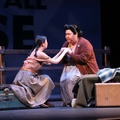Part 5 >>
Few prisoners spoke directly to the enemy in protest but some were willing to speak up when ordered to do so. According to Amano, the military conducted a court martial of the soldier accused of shooting Kanesaburo Oshima, calling ten Japanese as witnesses. One courageous witness, Shindo Tamezo, testified that the soldier said, “I don’t care, he’s just a Jap” after firing at Oshima. After the accused soldier denied hearing requests to hold fire, Tamezo angrily called him a liar, noting that the sentry in the watchtower heard the request. Amano claimed that an officer then yanked the soldier’s stripes from his uniform.
These incidents empowered the prisoners to outwardly resist. Overt demonstrations of Japanese pride replaced the silent protests and whispered insults. Amano related an amusing story of coercing an American officer, identified as Lieutenant Baxter, to show respect by attaching the suffix, -san, to his name. Calling out Amano-san, or “honorable Amano,” would invite the polite response of “hai,” a respectful form of “yes” in Japanese. The following day, Lt. Baxter took roll by solemnly calling out every prisoner’s name, adding -san to each one. Some of the prisoners could not refrain from giggling.
Laughter was an important coping mechanism for these men. Amano recalled the first laugh, months before, on the night of his arrest, when his employees greeted him with words of welcome. He replied, “What do you mean, welcome? This is jail!” Everyone laughed with relief.
The prisoners grew bolder. The Panama group invited the Hawaii group and the Missoula group of Californians to join in a celebration of the emperor’s birthday, Tencho-setsu (April 29). Many required instruction in the meaning and customs of the holiday. Ultimately, only the Hawaiians joined the Panamanians in marching to an open area in the middle of camp, bowing in the direction of the emperor and shouting “banzai.” Amano described the scene:
We had all been trained in elementary school to accept orders and marched along, no practice required. All the soldiers wondered what was going on. The tower guard turned the machine gun towards us. I was at the end of the line and I worried. I regretted our decision already but the others continued to march along. The groups stopped at Road #3. Everyone turned towards the emperor. Suddenly, I could picture green pines, the Nijubashi Bridge to the Emperor’s palace and a solemn scene unfolded in my imagination. We bowed deeply, like rice plants just before harvest. Just then, the soldiers broke into applause. We felt safer then, overjoyed, and sang the Japanese anthem. We shouted ‘banzai!’ three times.
This defiant act united the prisoners holding Japanese, Panamanian, Costa Rican and American citizenship under the umbrella of their shared Japanese cultural heritage. The groups left Fort Sill a month after Tencho-setsu.
On May 28, orders arrived to transfer the Missoula, Hawaii, and Panama groups, a total of 700 prisoners, to Camp Livingston, Louisiana. The camp, a U.S. Army internment facility near Alexandria, Louisiana, already held a number of German and Italian nationals in addition to Issei recommended by Immigration and Naturalization Service (INS) hearing boards for permanent interment. During the twelve-hour journey by train, a Costa Rican prisoner, identified as “N,” covertly resisted his captors by passing along secret information to Amano. “N” whispered to Amano that the American military attempted to destroy the Amano Maru on December 7, 1941. “N,” at the time a fisherman aboard the Arletta, claimed that two bombers misidentified his boat as Amano’s, bombing and strafing the deck with bullets. Sailors aboard the U.S.S. Erie detained the Arletta’s crew of seven Japanese men. As “N” spoke, he unwrapped a small copper shell, saved from the incident, but the conversation ended as the train stopped.
The prisoner groups marched together towards barracks spread out along Paradise Avenue, a name the prisoners found infuriating. They had hoped to remain united but were divided into two sections. Conditions at Camp Livingston were dramatically different than those at Fort Sill. To the relief of the prisoners, guards at the camp watchtowers did not have machine guns. While the food was of lower quality, the barracks proved to be far more comfortable than Fort Sill’s leaky tents. Amano could see the pine forest from his room. “After it rained, fog would form. In the fog, the pines took on various shades of gray, dark to light like a Chinese watercolor in black and white.” Some prisoners filled their days with games of go and mahjong, while others created displays of collected rocks and hand-polished pine burls. Amano admitted that life in prison was, at times, almost pleasant.
The most significant improvement for the prisoners at Camp Livingston was “open access to newspapers – the New York Times, local papers and Japanese American papers, the Nichibei Shinbun. No more starving for news.” The prisoners formed a news group of translators who daily produced three handwritten copies of an edited digest for distribution to the Panama, Hawaii and Missoula groups. The prisoners could finally follow the battles in detail but they also gained perspective on the United States. Amano defiantly concluded:
If I were to describe in one word the attitude of the American public towards the Japanese, it would be “disrespect.” Of course, there were exceptions such as Senators Wheeler, Nye, and La Follette. Even before them, William Randolph Hearst and Charles Lindberg warned that the Japanese would not be an easy adversary. However, like those unaware that a tidal wave is about to engulf their tiny island, the American people disregarded warnings.
He believed that the Japanese had greater resources than the Americans realized and that the American public had good reason to be frightened.
Amano described the battles in the Pacific theater in great detail, critiqued the statements by military officers and argued about the accuracy of reporting. The cartoons, in particular, bothered him. He remarked:
Naturally, the daily newspapers never forgot to print caricatures poking fun at Japan. For example, one cartoon depicted a little man with a worried look, supposedly Japan, with his feet mired in the mud that represented China. He was facing huge storm clouds representing the United States, England and Australia. This caricature showed that Americans thought that the Japanese were weakened by four years of fighting in China. Therefore, they would not be difficult to defeat. Another sketch depicted a little mean looking man with slanted eyes and two faces. One faced Thailand and Indonesia, and the other, with a humbled expression, faced America. This showed how America looked at and thought about Japan.
Yet Amano noted that the newspapers presented the Japanese as a formidable adversary. He also believed that the Latin Americans were secretly delighted by setbacks suffered by the United States.
As the number of overt displays of resistance decreased at Camp Livingston, the prisoners could not help becoming pessimistic. Since many of the internees were older, they did not believe they would be set free in their lifetimes. The permanent construction of the barracks rather than temporary tents confirmed their worries. Rumors began to circulate about a prisoner exchange boat, the Gripsholm, and the possibilities of repatriation. The ship was scheduled to leave on June 12, 1942.
On June 4, camp officers called thirteen names listed for repatriation. Amano described them as mostly employees of big companies, primarily from the Missoula group, with one employee of NYK (Nihon Yusen Kaisha, a shipping company) from Hawaii and one barber from Panama. “At 4:30 p.m., twelve of the thirteen people selected were loaded onto a truck with a military escort and departed. From those of us who remained, surrounded with barbed wire, came a sad and mournful “banzai.” Amano praised the actions of the thirteenth person on the list who signed a waiver allowing his former employee with a young family to take his place on the exchange boat, calling him a “man among men” and the embodiment of a “true Japanese.” The employee was not allowed to take the place of his boss so neither boarded the truck.
After a second group departed, those left behind began to construct little shrines out of scraps of wood and sticks and pray for a third list that would contain their names. To the prisoners’ surprise, military officials released a third list on June 12. Amano recalled, “at the time, I was taking part in a hotly contested game of go.” Told he was on the list, “I continued to make another move without taking my eyes off the board. I wasn’t going to be fooled by a trick like that.”
Indeed, Amano and three of his former employees were on the list of five names. Two days later, Amano made a farewell speech that began “Someday, let us all meet on the pier at Yokohama. That day is closer than you think. Do not lose faith. Stay well and persevere!” The train to New York and the Gripsholm departed on June 14, 1942.
© 2010 Esther Newman





